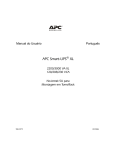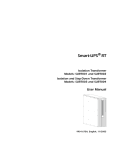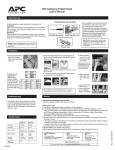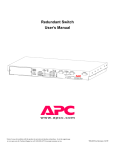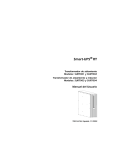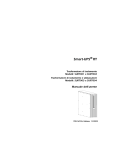Download RS User Manual E
Transcript
Note! When managed by PowerChute UPS software the Redundant Switch should be used with Servers running Windows NT. Smart-UPS Redundant Switch User’s Manual English 990-0275A, Revision 2 5/98 Initial Start-Up To obtain warranty coverage, please fill out and return the warranty registration card now. Inspection Inspect the Redundant Switch upon receipt. Notify the carrier and dealer if there is damage. The packaging is recyclable; save it for reuse or dispose of it properly. Placement Rear View Model SU041 CAUTION: L UNINTERRUPTIBLE RISK OF ELECTRIC SHOCK. DO NOT REMOVE TOP COVER. NO USER POWER SUPPLY SERVICEABLE PARTS INSIDE. REFER SERVICING TO QUALIFIED SERVICE PERSONNEL. ® ACCESSORY FOR USE IN A CONTROLLED ENVIRONMENT. REFER TO MANUAL FOR ENVIRONMENTAL CONDITIONS. I S T E D 4L2RC6 23 9 3 8 MADE IN USA THIS EQUIPMENT USES TWO (2) AC SOURCES E95463 MODEL : S/N: THIS DEVICE COMPLIES WITH PART 15 OF THE FCC RULES. OPERATION IS SUBJECT TO THE FOLLOWING TWO CONDITIONS: Voltage Source Load 120 V 5-15 5-15 1.THIS DEVICE MAY NOT CAUSE HARMFUL INTERFERENCE AND 2.THIS DEVICE MUST ACCEPT ANY INTERFERENCE RECEIVED THAT MAY CAUSE UNDESIRED OPERATION. •Plug the power cords attached to the Redundant Switch into each UPS. •Follow the UPS installation instructions in the Smart-UPS Quick Reference Guide to install the UPS. •Both UPS units should be the same sine-wave model. •Install the 940-1000A communication cable(s) between each UPS and the Redundant Switch. Make sure that the communications cable for the preferred UPS, UPS-A, and the power cord for UPS-A are connected to the same UPS. 3. Turn on all connected equipment 2. Connect Equipment Install the Redundant Switch in a protected area that is free of excessive dust and has adequate air flow. Do not operate the Redundant Switch where the temperature and humidity are outside the specified limits. Warning: Changes or modifications to this unit not expressly approved by the party responsible for compliance could void the warranty. Installation This Redundant Switch is equipped with a SmartSlot for additional manageability. See the APC Website (www.apcc.com) for information on plug-in accessories. •Do not power laser printers through the Redundant Switch. Use your server’s power cords to connect to the Redundant Switch. Note: If you have more than two power cords to connect, use a power strip. APC recommends that you do not use a surge protective power strip. •Install the PowerChute® plus communication cable between the Redundant Switch’s server port and the server’s serial port. 1. Install Redundant Switch Press the ON switch of UPS-A to turn on your Redundant Switch and UPS-B. This will power-up connected equipment. Note: To test whether the cabling is correct, shut off one UPS using its OFF button. If it turns back on, the cabling is correct. If not, swap the two UPS communication cables. Storage Store Redundant Switch covered and upright in a cool, dry location. Remove any accessories in the accessory slot and disconnect any cables connected to the server interface port. •Before plugging in the unit, install any compatible SmartSlot accessory. Refer to the Release Notes found in the CD included with the Redundant Switch for detailed information. Follow the installation instructions that come with the accessory. Supported Configurations Two connection configurations are supported for Redundant Switch. They are illustrated below. Note: Redundant Switch does not support communications with accessories installed in the UPS. Install the accessory you need in Redundant Switch. Better Configuration: Smart-UPS Redundant Switch with two Smart-UPS units connected to one AC line. This configuration is the minimal acceptable, since both UPS units depend on one facility power source. Note: Both UPS units should be the same sine-wave model. Best Configuration: Smart-UPS Redundant Switch with two Smart-UPS units connected to two separate AC lines. This configuration is better than the previous, since each UPS unit receives power from a separate facility power source. Note: Both UPS units should be the same sine-wave model. PowerChute® plus Configuration Procedure 1. Install PowerChute® plus following the instructions in the enclosed Software Installation Instruction Sheet. 2. Start up PowerChute® plus. By default, communication is to UPS-A. 3. Configure UPS-A according to your requirements. 4. Set the UPSID to UPS_A. 5. At the Redundant Switch front panel, set the Source Preference to Source B. 6. Restart the computer on which PowerChute® plus is installed. 7. Restart PowerChute® plus. Communication is to UPS-B. 8. Configure UPS-B to be identical to UPS-A except • UPS-B should be set to not perform self-tests. • Set the UPSID to UPS_B. 9. At the Redundant Switch front panel, set the Source Preference to Source A. 10. Restart the computer on which PowerChute® plus is installed. 11. Restart PowerChute® plus. Communication is now to UPS-A. Notes High availability is the condition in which both UPSs are available to supply AC power. Standard availability is when only one UPS is fully available for back up power. A loss of power to either input of Redundant Switch results in a “self test failed: invalid test” message from PowerChute which indicates a change from high availability to standard availability. If UPS-A fails, Redundant Switch senses this and transfers the load’s AC power input and PowerChute communication to UPS-B. During a transfer from one source to the other Redundant Switch is designed to interrupt communications with PowerChute® plus for three seconds (forcing a “lost comm” event through PowerChute) . PowerChute® plus then attempts to reestablish communications (with the available UPS). You are notified that the server AC power has gone from high availability to standard availability when PowerChute® plus records the following message: Alternate UPS engaged or lost comm. Examine Redundant Switch for details. When the selected UPS self-tests, Redundant Switch switches to the other UPS, causing a self-test of that UPS, then switches back. Operating Instructions Front View Status To UPS B Status Select Select Level R T N I + N 2 4 AC Source B A To UPS A To Server Function Bright Source selected EPO Dim Emergency Power Off Off Source OK, but not selected Source not OK R e d u n d a n t Sw i t c h Note: Only the Factory Default settings shown below should be used. Check that these are the current settings for your unit. Additional setting are for future upgrades. Function Source A Sensitivity Factory Default Reduced User Selectable Choices LED Bright LED Dim LED Off Normal Reduced Low Source B Sensitivity Reduced Normal Reduced Low Source Preference Source A Xfer Voltage Source B Xfer Voltage Source A Medium Medium Source A Narrow Narrow Source B Medium Medium None Wide Wide Emergency Power Off The UPS may be switched off by a remotely operated Emergency Power Off (EPO) control. Such a configuration is common in computer rooms and laboratories where, for safety reasons, power to the loads must be disconnected. To connect Redundant Switch and its attached Smart-UPS to your emergency power off system, use the EPO connector. Use a normally-open contact to connect the +24 terminal to the IN terminal. A certified electrician can wire the external blue four-pin female connector to the emergency power off system. If this is done, and the emergency power off system is activated, neither UPS will go onbattery. Cautions • The EPO interface is a Safety Extra Low Voltage (SELV) circuit and may be connected only to other SELV circuits. • The EPO interface is designed to monitor circuits that have no determined voltage potential. Such closure circuits may be provided by a switch or relay properly isolated from the utility. Connection of the EPO interface to any circuit other than a closure type circuit may cause damage to the Redundant Switch. Front Panel User Programming User programmable settings are accessible using controls located on the Redundant Switch front panel. Troubleshooting Redundant Switch Problem Redundant Switch will not turn on. Possible Cause Very low or no utility voltage. Server cannot communicate with attached UPS through Redundant Switch. Communications cabling problem or internal Redundant Switch fault. Description Sets transfer sensitivity to line conditions Sets transfer sensitivity to line conditions Selects the preferred AC source Sets the transfer voltage window Sets the transfer voltage window Function Select LED Indicator The three green Function Select LEDs indicate which user programmable parameter is selected for status display or modification. Use the left Select button to cycle through the five user configurable items listed above. Function Status LED Indicator The green Function Status LED indicates the state of the selected user programmable function. Use the right Select button to cycle among the choices. AC Source LED Indicator The green on-line LED indicates the line quality and select status of each source: Bright = source selected; Dim = source okay, not selected; Off = source not okay; 1 second flashing of 1 LED, other LED off = both AC sources are out of tolerance. Source Sensitivity Generators connected to the Redundant Switch are not supported. However, Redundant Switch detects line voltage distortions such as spikes, notches, dips, and swells, as well as the distortions inexpensive fuel-powered generators typically produce. By default, the UPS reacts to distortions by transferring to on-battery operation to protect the loads. Where power quality is poor, Redundant Switch will change from the primary source UPS to the alternate UPS. If the loads can operate normally under such conditions, battery capacity and service life may be conserved by reducing the sensitivity of the UPSs, and setting the Source A and Source B Sensitivity to Low on the Redundant Switch. Troubleshooting the High Availability System Corrective Action Check the AC power supply to the Redundant Switch with a table lamp. If very dim, have the utility voltage checked. Check that AC plugs are properly connected between Redundant Switch and the UPSs. Check the three communication cable connections. If they are tight and there is still no communication, connect the server directly to a UPS. If there is now communication, there is an internal Redundant Switch fault. In any case, Contact APC customer service (see Service section). See Service section, below. Problem/Severity (1=low, 4=high) UPS-B communications problem. Severity = 1 High Availability System Response Load not interrupted; PowerChute plus self-test reports error. UPS-A communications problem. Severity = 2 Load not interrupted; Redundant Switch checks communications continuously. UPS-B loses ability to deliver load if engaged. Severity = 3 Load not interrupted; Redundant Switch and PowerChute plus monitor continuously. If the Redundant Switch requires service do not return it to the dealer! Follow these steps: 1. Use the Troubleshooting section to eliminate common problems. 2. If the problem persists, call customer service or visit the APC Internet Website (www.apcc.com). •Note the model number of the Redundant Switch, the serial number, and the date purchased. A technician will ask you to describe the problem and try to solve it over the phone, if possible. If this is not possible the technician will issue a Return Merchandise Authorization Number (RMA#). •If the Redundant Switch is under warranty, repairs are free. If not, there is a repair charge. 3. Pack the Redundant Switch in its original packaging. If the original packing is not available, ask customer service about obtaining a new set. •Pack the Redundant Switch properly to avoid damage in transit. Never use Styrofoam beads for packaging. Damage sustained in transit is not covered under warranty. •Include a letter with your name, RMA#, address, copy of the sales receipt, description of the trouble, your daytime phone number, and a check (if necessary). 4. Mark the RMA# on the outside of the package. 5. Return the Redundant Switch by insured, prepaid carrier to the address given to you by Customer Service. UPS-A drops output voltage Severity = 4 Load not interrupted; Redundant Switch checks continuously. Redundant Switch engages UPS-B for load delivery and communications proactively. All Redundant Switch LEDs Internal, automated self-test are flashing. failure: defective unit For Computer Interface Port Specifications, see the APC Website (www.apcc.com). Service North & Latin America Europe APC APC 132 Fairgrounds Road Ballybritt Business Park West Kingston, Rhode Island 02892 USA Galway, Ireland 10800-702000 1-800-800-4APC/1-401-789-5735 353-91-702020 Internet: http://www.apcc.com E-Mail: E-Mail: [email protected] North America: [email protected] Latin America: [email protected] PowerChute plus Response Either: •self-test at UPS failed, invalid test •unable to communicate with UPS PowerChute plus alerted immediately. Either: •self-test at UPS failed, invalid test •unable to communicate with UPS PowerChute plus alerted immediately. Either: •self-test at UPS failed, invalid test •unable to communicate with UPS PowerChute plus alerted immediately. Either: •self-test at UPS failed, invalid test •alternate UPS engaged or lost comm. View Redundant Switch display for details. Corrective Action Diagnose communications path to Redundant Switch. Initiate Self-Test through PowerChute plus. Diagnose UPS-A. Initiate Self-Test through PowerChute plus. Diagnose UPS-B. Initiate Self-Test through PowerChute plus. Diagnose both UPS units. Specifications Acceptable input voltage Output voltage Frequency limits (on-line operation) Transfer time Maximum load Operating temperature Storage temperature Operating and storage relative humidity Operating elevation Storage elevation Electromagnetic immunity Audible noise in dBA @ 1 m (3 ft) Size (H x W x D) Weight - net (shipping) Safety approvals EMC verification 120 VAC: 0 - 165 VAC 120 VAC: 108 - 132 VAC (by default) 50 or 60 Hz, ±5% 6 ms typical 1400 VA 12 A 0 to +40 ºC (+32 to +104 ºF) -15 to +45 ºC (+5 to +113 ºF) 0 to 95%, non-condensing 0 to +3,000 m (0 to +10,000 ft) 0 to +15,000 m (0 to +50,000 ft) IEC 801-2, 801-3, 801-4 <45 4.45 x 43.2 x 19 cm (1.75 x 17.0 x 7.5 in.) 4.5 (6.8) kg/10 (15) lb. Listed to UL 1778, certified to CSA 107.1 120 VAC: FCC Class A certified





